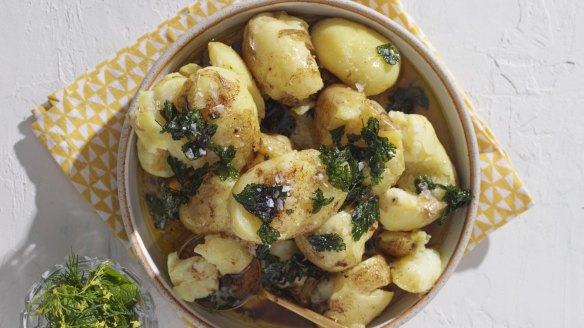The difference between flat-leaf and curly parsley

What is the difference between flat-leaf and curly parsley? B. Jackson
The former is used in restaurants, and the latter decorates meat trays. Flat-leaf parsley (Petroselinum crispum neapolitanum, also known as Italian parsley) has a more robust flavour and smoother mouthfeel than curly parsley (P. crispum), and is also easier to wash. Flat-leaf parsley surpassed its curly cousin as the green herb of choice about the turn of the last century. Today, curly parsley has an association with tomato rosettes, carved carrots, and other not-intended-for-consumption-garnishes that were the hallmarks of French-trained chefs of the mid-20th-century. In other words, it's daggy. But both types add colour and a clean, lean, high note to all the dishes they are added to.
When a recipe just states vinegar as an ingredient, is it OK to use apple cider vinegar? R. Fox-Lane
Some kinds of vinegar are more acidic than others so it depends on the dish. Apple cider vinegar has a rich flavour and delicate sharpness that makes it my favourite vinegar for everyday salad dressings. But sometimes a sauce needs a squeeze of lemon juice, or a casserole screams out for the nuttiness of sherry vinegar, and some baking recipes require very acidic distilled (white) vinegar. So choose the vinegar based on the dish you're cooking.
What do I do with feijoas? L. Mulraney
Autumn-fruiting feijoas are like zucchinis in that one minute they are just about ripe, and the next week every person with a tree is trying to rehouse them. Sour as an old-school librarian and fragrant like Juicy Fruit chewing gum, feijoas are a type of guava that originated in the temperate regions of Brazil and Argentina. Peak season is usually April-May. The slightly granular flesh is packed with fibre and vitamin C. I bought a jar of remarkably good bottled feijoas from Prom Coast Food Collective (promcoastfoodcollective.com.au). Hand-peeled feijoa halves were carefully packed into a jar and covered with a light sugar syrup, and given enough time in a heat bath to pasteurise the fruit and seal the jar. Scooped out of its bumpy green skin, the flesh can also replace bananas in cakes, be preserved in jellies, jams and chutneys, and combined with apple in crumbles. It's also a beautifully aromatic addition to a fruit salad.
Letters
Recently we were talking about using the pasta cooking water to thicken a pasta sauce. This response came from a famous but now retired chef who wished to remain anonymous. "I was lucky to be working at the Queenscliff Hotel when Ivana (can't remember her surname; it was always just Ivana) would come in twice a week to make all the pasta for the pub. She used the pasta water to thicken sauces but I also noticed that she used a lot less water in which to cook the pasta than I was used to doing. This made the pasta water much starchier." Thank you for the beautiful memory.
Send your vexing culinary conundrums to brainfood@richardcornish.com.au or tweet to @realbrainfood.
Appears in these collections
Restaurant reviews, news and the hottest openings served to your inbox.
Sign upMore:
From our partners
Original URL: https://www.smh.com.au/goodfood/eating-out/the-difference-between-flatleaf-and-curly-parsley-20200609-h1omrn.html
